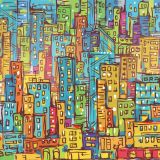In this article:
What is a Commercial Art Degree?
A commercial art degree focuses on teaching students how to create art that is used for business purposes, like advertising, marketing, and product design. It combines creativity with practical skills so students can design images, layouts, and graphics that help sell a product, share a message, or promote a brand. This kind of art is less about personal expression and more about meeting the needs of clients or companies.
Students in a commercial art program learn how to use tools like drawing, photography, and digital software to create logos, advertisements, packaging, and promotional materials. They study visual communication, color theory, typography, and design principles. The goal is to help students understand how to catch people’s attention and communicate clearly through images and design.
Program Options
There are several education paths for those interested in commercial art, depending on career goals and time commitment:
- Certificate in Commercial Art: This short program teaches the basics of visual communication, design software, and illustration techniques. It’s ideal for those looking to enter the field quickly or build a foundation for further study.
- Associate Degree in Commercial Art: A two-year program that covers drawing, typography, digital design, and visual storytelling. It prepares students for entry-level positions in graphic design, advertising, or media production.
- Bachelor’s Degree in Commercial Art or Graphic Design: This four-year degree provides in-depth training in art and design, including branding, web design, and portfolio development. It’s suited for students who want to pursue long-term careers in creative industries or advance into leadership roles.
- Master’s Degree in Graphic Design or Visual Communication: These programs focus on advanced design theory, brand strategy, interactive media, and creative direction. Students often work on complex design projects and build a professional portfolio. Some programs also include research components or opportunities to teach design courses.
- Master of Fine Arts (MFA) in Commercial Art or Related Fields: An MFA is a terminal degree in the arts, emphasizing creative development, conceptual thinking, and professional practice. While not always labeled specifically as "commercial art," many MFA programs allow students to focus on areas like graphic design, advertising design, or digital illustration, which align closely with commercial art careers.
Skills You’ll Learn
Students in a commercial art degree program gain a blend of creative and technical skills that prepare them for work in design and media industries. These include:
- Digital Design Tools: Students become proficient in industry-standard software like Adobe Photoshop, Illustrator, and InDesign for creating visual content.
- Typography and Layout: Training includes selecting and arranging type, creating effective page layouts, and balancing visual elements for readability and impact.
- Illustration Techniques: Programs often cover both traditional and digital illustration methods for use in advertising, product packaging, and editorial design.
- Visual Communication: Students learn how to convey messages clearly through images, color, and design, with a focus on audience engagement and branding.
- Photography and Image Editing: Some courses include basic photography skills and photo editing for use in marketing materials and promotional designs.
- Portfolio Development: Throughout the program, students build a professional portfolio showcasing their design work, which is essential for job placement after graduation.
What Can You Do with a Commercial Art Degree?
A commercial art degree opens the door to various career opportunities in the creative field. Here are some potential job options:
- Commercial Artist: Commercial artists create artwork for commercial purposes, often working on projects that require specific themes or messages. They may collaborate with clients to develop custom designs for advertising, branding, and promotional materials.
- Graphic Designer: Graphic designers create visual content for websites, advertisements, and marketing materials. They use design software to develop logos, brochures, and other promotional items that communicate messages effectively.
- Illustrator: Illustrators produce original artwork for books, magazines, advertising, and digital media. They may work in traditional mediums or digitally, using their creativity to bring stories and concepts to life.
- Art Director: Art directors oversee the visual aspects of a project, guiding the overall look and feel. They work closely with designers and illustrators to ensure that the final product aligns with the client’s vision and brand identity.
- Web Designer: Web designers focus on creating visually appealing and user-friendly websites. They combine graphic design skills with an understanding of web technology to develop layouts, graphics, and interactive features.
- Commercial Photographer: Commercial photographers specialize in taking photos for commercial use, such as advertising, product photography, and corporate branding. They use their artistic eye to capture images that convey messages effectively.
- Exhibit Designer: Exhibition designers plan and create layouts for exhibits in museums, galleries, and trade shows. They work to ensure that the design effectively showcases the content and engages visitors.
- Marketing Specialist: Uses design and messaging to help promote products or services, often working with creative teams to develop campaigns that align with marketing goals.
- Packaging Designer: Packaging designers create attractive and functional packaging for products. They consider factors like materials, branding, and consumer appeal to develop designs that stand out on store shelves.
- Brand Strategist: Brand strategists focus on developing and maintaining a brand’s identity. They analyze market trends and consumer behavior to create visual strategies that enhance brand recognition and loyalty.

